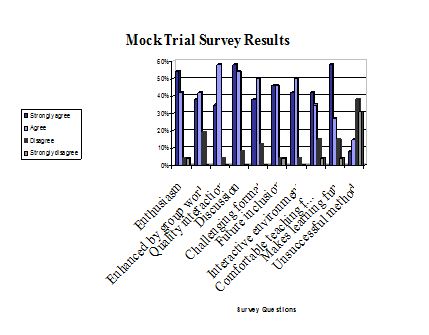ABSTRACT
Marshall University, JCESOM’s second-year medical students worked in teams to debate the validity and interpretation of clinical-pathologic findings in a “mock-medical malpractice trial” setting. This teaching format is based on the principles of teamwork and critical thinking. Student feedback on this approach to clinical case-based teaching was overwhelmingly positive.
A clinical pathology conference on tuberculosis was taken from the New England Journal of Medicine and used as the basis for our mock trial. The family of a 43 year-old man with fever and night sweats is suing the clinician, Dr. No, for delay in diagnosis. The trial was strictly student-driven, and the instructors were present only as facilitators. The class of 46 was divided into five groups: Judge (8), Prosecution (9), Defense (9), Witnesses for Prosecution (10), and Witnesses for Defense (10). Students were encouraged to work together as a group and select an individual(s) to act as the main presenter(s) for the group and interact with other groups. Students were given the freedom to choose a different interpretation of the data provided. For example, it was fair for the defense to have another pathologist testify with a different interpretation of the pathologic data. Upon request an image files of the pictures and figures in the article were provided. Students were surveyed for the effectiveness of this form of instruction.
The results of the survey indicate the following: 93% of the students indicated that quality interaction was created with this teaching format; 92% indicated that it stimulated interactive environment for learning; 96% agreed that it made learning fun. We believe this teaching format is useful for virtually any subject matter and variety of teaching modalities can add spice to good teaching.
Basic science years are often difficult for the students since the material can be overwhelming and dry. By creating active learning methods, students become motivated to master even the most tedious material. Although this teaching format is untraditional, it presents students with unusual challenges to better enable them to comprehend the material.

REFERENCES
1. Herreid, C.F . Case studies in science: A novel method of science education. Journal of College Science Teaching 1994; 23:221–229.